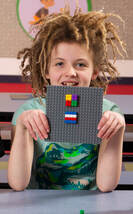 It’s easy to adapt a program used in schools to create a homeschool curriculum that works well for your kids. Here are five tips for teaching a new curriculum when you're starting to homeschool. 1. Watch an expert to see how the program is taught. Now that you’re the teacher, it will really help to learn the important terms to include and see the lesson in action. Brick Math has lots of video lessons for you and your child to watch, all taught by the author of the program, Dr. Shirley Disseler (aka “Dr. D”). 2. Read through the whole lesson before you start teaching it. (This is the same advice that cookbook authors give about reading through the whole recipe before you start cooking!) It’s critical that YOU understand what you’re teaching before you start. With math, that’s key. Most of us learned math in a very different way than we would teach it today. Make sure the whole lesson “makes sense” to you before you begin working with your child. Each Brick Math lesson is step-by-step, so as you read it, you can feel comfortable with each step along the way.  3. Gather all the materials you need for the lesson before you start. You don’t want to lose momentum by having to stop and search for pencils, paper, or manipulatives. When you and your kids are ready to learn, you want to take full advantage of the time you have! At the beginning of each chapter in every Brick Math book there is a list of the LEGO bricks and baseplate needed to teach the lessons in that chapter, so make sure you have those, either from your personal stash of LEGO bricks, or from the Brick Math brick set. Your student will draw models and answer questions in the student books. All you need to add are pencils or markers, and you’re ready to go. 4. Take as much time as your child needs to complete a lesson. One of the best features of homeschooling is that kids work at their own pace, not at the pace of a whole class full of students. Check as you go along to be sure that your child really understands the material every step of the way. The Brick Math program includes regular check-ins with the student, and assessments for each chapter that give you confidence that your child has learned the math.  5. Make it fun! Many homeschooling parents are proud to talk about how much their children enjoy learning through the creativity of their programs. And what’s a more fun way to learn math than building with LEGO bricks? Students everywhere tell us how much fun they have learning math this way. Teachers have told us that sometimes their students ask to “keep doing Brick Math” rather than have recess! Brick Math is a K-6 math curriculum that works for all students, whether they are in a classroom or learning at home one-on-one. If you have a student at home who is learning math, check brickmath.com. The website includes videos for both teacher/parent training and direct instruction of students. You can learn more about how Brick Math improves student math test scores and hear what people who are using Brick Math have to say about the program. Brick Math is a K-6 math curriculum that uses LEGO® bricks to model 11 different math subjects: Counting, Addition, Subtraction, Multiplication, Division, Basic Fractions, Basic Measurement, Fraction Multiplication, Fraction Division, Advanced Measurement and Geometry, and Decimals. It works well for math intervention, for enrichment, and as a whole-school program. Materials are simple and need not be shared between students. It adapts easily to online instruction. Contact us with any questions.
0 Comments
|
Categories
All
Archives
July 2024
|


